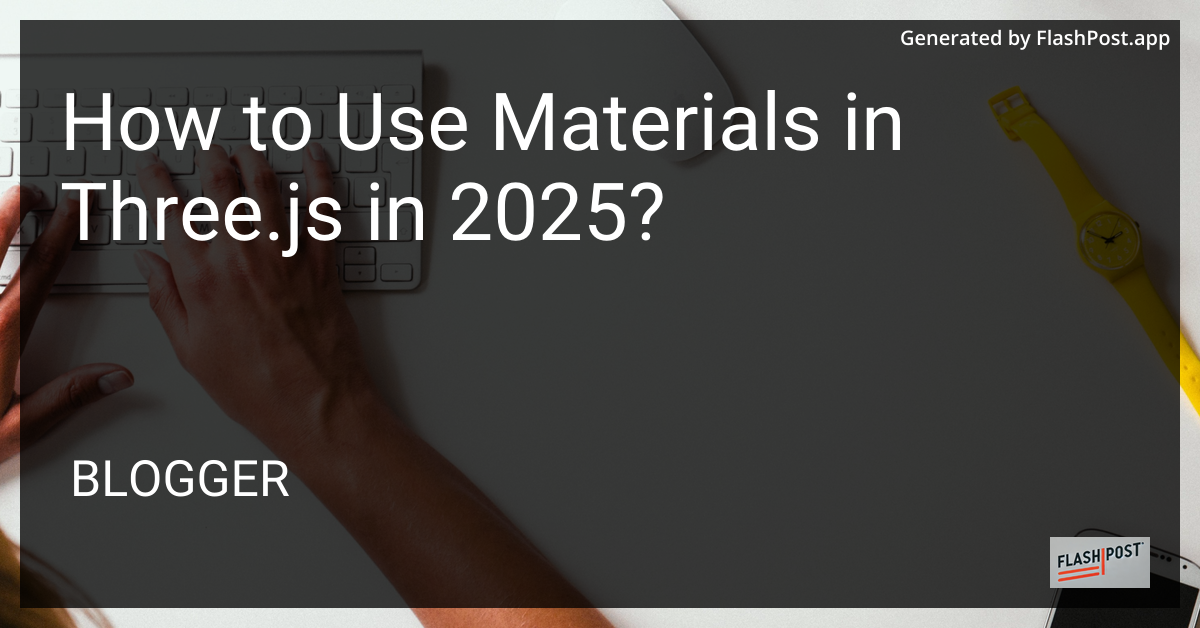How to Use Materials in Three.js in 2025?

How to Use Materials in Three.js in 2025
In 2025, Three.js continues to be a leading 3D graphics library, providing developers with the tools to create stunning visual content on the web. Understanding how to effectively use materials in Three.js is crucial for crafting realistic and engaging 3D scenes. This guide will walk you through the latest techniques for using materials in Three.js in 2025.
Best Three.js Books to Buy in 2025
| Product | Features | CTA |
|---|---|---|
 Vue.js 3 for Beginners: Learn the essentials of Vue.js 3 and its ecosystem to build modern web applications |
Buy it now 🚀

| GenerateAmazonOfferMarkdownDevto|
 3D Web Development with Three.js and Next.js: Creating end-to-end web applications that contain 3D objects (English Edition) |
Shop Now

| GenerateAmazonOfferMarkdownDevto|
 Game Development with Three.js |
Don't miss out ✨

| GenerateAmazonOfferMarkdownDevto|
 Interactive Web Development with Three.js and A-Frame: Create Captivating Visualizations and Projects in Immersive Creative Technology for 3D, WebAR, ... Using Three.js and A-Frame (English Edition) |
Grab yours today 🛒

| GenerateAmazonOfferMarkdownDevto|
 J.S. Bach: Inventions and Sinfonias BWV 772–801 | Henle Urtext Piano Sheet Music (Revised Edition) | Baroque Masterwork for Study and Performance | ... French, German) (Multilingual Edition) |
Check Price

| GenerateAmazonOfferMarkdownDevto
What are Materials in Three.js?
Materials in Three.js define the appearance of objects. They control properties such as color, texture, reflectivity, and shading. Materials work with lights in the scene to create realistic visual effects. In 2025, Three.js offers a broad array of materials including basic, standard, physical, and shader materials, each suited for different applications.
Setting Up Your Three.js Environment
Before diving into materials, ensure your development environment is set up with the latest version of Three.js. Here’s a quick checklist:
Install Node.js and npm: Make sure Node.js and npm are installed on your machine for easy package management.
Set Up a Basic Project: Initialize a basic Three.js project by running
npx create-three-app my-three-app.Import Three.js: Use ES6 imports to include Three.js in your project:
import * as THREE from 'three';Using Basic Materials
Creating a Basic Material
A basic material can be used for non-shiny surfaces that don’t react to lights. Here’s how you can set up a basic material:
const material = new THREE.MeshBasicMaterial({ color: 0x00ff00 });
This simple green material is perfect for objects like cubes or spheres when lighting effects are not needed.
Advanced Materials
The Standard Material
For more realistic objects that respond to lighting, use the MeshStandardMaterial. It supports lighting and gives a metallic or rough appearance.
const standardMaterial = new THREE.MeshStandardMaterial({
color: 0xffffff,
metalness: 0.5,
roughness: 0.5
});
Using Physical Material
The MeshPhysicalMaterial in Three.js 2025 offers advanced features such as clear coat effects and sheen for real-world simulation.
const physicalMaterial = new THREE.MeshPhysicalMaterial({
color: 0x00ff00,
clearcoat: 1.0,
sheen: 0.5
});
Textures and Maps
To add details to your materials, use textures and maps. These include diffuse maps, specular maps, and normal maps to enhance surface details.
Applying a Texture
const textureLoader = new THREE.TextureLoader();
const texture = textureLoader.load('path/to/texture.jpg');
const texturedMaterial = new THREE.MeshStandardMaterial({
map: texture
});
This method allows you to apply a texture to your 3D object, enhancing its visual complexity significantly.
Exploring Custom Shaders
Custom shaders provide the ultimate flexibility by allowing you to define exactly how your surfaces should look. This requires GLSL knowledge but can yield unique results.
const customShaderMaterial = new THREE.ShaderMaterial({
vertexShader: '...', // Add your vertex shader code here
fragmentShader: '...' // Add your fragment shader code here
});
For more about integrating custom shaders, check out resources like data visualization JavaScript or explore techniques for passing array data in URL with JavaScript.
Conclusion
Mastering materials in Three.js opens up a realm of possibilities for creating visually stunning 3D graphics on the web. As we advance into 2025, leveraging the full potential of Three.js materials—through basic, standard, physical, and custom shader materials—will be integral to crafting immersive digital experiences.
For more advanced visualization techniques, consider exploring how to create an event timeline in JavaScript.
By staying updated with the latest features in Three.js, you can ensure your projects remain at the cutting edge of web-based 3D graphics.
Comments
Post a Comment